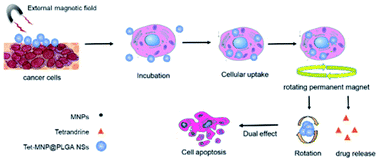Enhancing cellular morphological changes and ablation of cancer cells via the interaction of drug co-loaded magnetic nanosystems in weak rotating magnetic fields
Abstract
Magnetic nanoparticles have been widely used in cancer treatment for their potential magnetic functions and synergistic antitumor effect with therapeutic agents. In this work, we developed a polymeric nanosystem by co-loading the natural anticancer drug tetrandrine and superparamagnetic iron oxide nanoparticles for cancer combinatorial therapy. The nanosystem possessed regular morphology and superior magnetic properties. Under the action of external rotating permanent magnets, the nanosystem could transfer a rotational motion to damage the cellular membrane, which would result in the increased permeabilization of the cell membrane and damage to lysosomes. Hence, the specific characteristics of the magnetic nanosystem induced potent cytotoxicity and enhanced the effect of the tetrandrine-induced cell apoptosis. With further exploration, we found that this nanoplatform caused cell death via a lysosomal-mitochondrial apoptotic pathway with the upregulation of proapoptotic proteins (Cathepsin B, Smac/Diablo, Cytochrome C, and Caspase 3) and the down-regulation of antiapoptotic proteins (Bcl-2 and XIAP). These findings demonstrate that the combination therapy mediated by co-loaded magnetic nanosystems can be used for a multi-therapeutic effect against tumors in biomedical applications.



 Please wait while we load your content...
Please wait while we load your content...